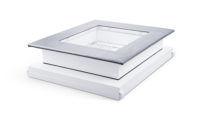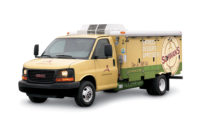Imagine walking into your warehouse and the lights come on automatically. You don’t even have to flip a switch. Effortless.
Today’s enhanced lighting options allow this process to happen anytime, anywhere in your facility. Even better is that this energy-efficient technology lights the way to unprecedented savings to the bottom line.
Here’s a breakdown of some cutting-edge LED lighting options for processing plants, distribution centers and cold storage facilities.
Exterior lighting with advanced wireless control
Over the last nine months, SmartWatt Energy, Inc. has introduced exterior LED building-mounted and site lighting along with advanced wireless control for cold storage warehouses, grocery chains, frozen vegetable producers, frozen meal producers and more.
“Interior lighting has been a popular measure untaken by our customers over the few years, however exterior lighting has largely been overlooked,” says Chris Covell, president of the Ballston Lake, N.Y., company. “With the emergence of LED lighting technology, there are great exterior lighting measures that can be utilized, which provide significant savings and a very attractive ROI.”
For example, SmartWatt Energy performed a full building audit of all lighting systems throughout ConAgra Foods Lamb Weston/RDO’s Park Rapids, Minn., facility, including processing spaces and a freezer warehouse for potential energy-savings upgrades. ConAgraFoods Lamb Weston’s goals were to dramatically improve the quality and quantity of light for employees and to reduce their environmental impact. As a result, SmartWatt Energy replaced 1,266 metal halide and T-12 fluorescent lighting fixtures with T-8 ones throughout the processing, packaging and storage areas, office, restrooms and maintenance and loading dock areas. SmartWatt Energy also installed LED high bays throughout the freezer warehouse, helping ConAgra Foods Lamb Weston/RDO shed 227.88 kW from their facility with a payback period of less than two years.
Intelligent lighting
Boston-based Digital Lumens introduced the new DLE line of intelligent LED fixtures—LightRules Power—and a new version of LightRules management software in October 2013.
“The new DLE intelligent LED fixtures offer higher lighting efficacy (more light output per watt used, or ‘lumens per watt’ in industry speak) in addition to integrated occupancy and daylight sensing, which can drive a more rapid payback on a lighting upgrade,” says Allison Parker, director of marketing. “Meanwhile, LightRules Power provides the ability to monitor other power loads—circuits, systems or machinery—via the LightRules software.”
The way it works is that integrated occupancy sensors turn lights on only when someone is in the area, and off or dimmed to a specified level when the area is vacant, Parker adds. The fixtures then gather data about when they were on and for how long and share that information with LightRules, which shows facility-wide lighting energy usage, occupancy patterns and more. If there needs to be changes to the lighting settings, LightRules provides a web-based interface for modifications.
“These smart lighting systems that respond to the environment around them are beneficial to both the facility staff and the bottom line—workers enjoy higher-quality light when and where they need it, while the facility is simultaneously saving energy by not lighting spaces that aren’t in use,” Parker says. “Because every second that a light is dimmed or off saves tremendous amounts of energy over the long term, customers typically see direct lighting energy savings of 90% vs. HIF, HID or HPS lighting.”
Lighting for low temps
Dialight, Farmingdale, N.J., offers a line of industrial and hazardous LED fixtures that are capable of handling temperatures as low as -40°C.
“Frozen food applications finally have the lighting solution they need to maximize maintenance savings while lowering total cost of ownership,” says Devin Sikorski, marketing associate. “In fact, LED technology is widely known to perform better in these conditions—the colder temperatures provide additional benefits for thermal heat management. When you combine this with Dialight’s advanced heat sink technology, LED fixtures serve as the perfect replacement for traditional HID lighting in these cold storage and frozen food applications.”
In September 2013, Dialight unveiled the Lighting and Design Resource Center, a cutting-edge lighting layout software that offers photometric files on a wide range of industrial and hazardous LED fixtures. This way, users can quickly generate thorough lighting layouts and evaluate how Dialight’s LED fixtures will perform in their application compared to traditional HID fixtures.
Furthermore, Dialight introduced an innovation program that has gained UL certification and CE compliance for its DuroSite LED high bay and low bay product portfolios. With efficiencies up to 107 lumens per watt, the new power supply is available in 17,000-3,800 lumen output fixture versions.
CE- and UL-approved
Banner Engineering Corp. released a line of energy-efficient, CE- and UL-approved LED lighting products that are suitable for industrial environments.
For instance, WLS28 LED strip lights feature sturdy aluminum housings, bright light output and a low-profile, space-saving design, while WLA area lights provide high-intensity uniform light with low-energy consumption and a clean white housing. WLB32 AC or DC LED light bar provides LED lighting with high-quality light output. WL50-2 LED work lights are compact, circular lights ideal for areas where space is limited. WLC60 and WLC90 heavy-duty LED lights are engineered to have superior performance in harsh environments. And, FLX18 flex arms are a bendable rod that allows for easy repositioning of work lights and spot lights. All options are water resistant, washdown safe, can operate in temperature ranges as wide as -40°C to 70°C, feature convenient and flexible mounting options and optional on/off switches and are highly resistant to vibration and shock.
“Banner’s LED lights illuminate areas for up to 50,000 hours. Depending on usage, that translates into 5-10 years or more without requiring maintenance—resulting in a low cost of ownership and a higher return on investment than fluorescent or incandescent lighting,” says Kathy Erickson, technical marketing manager for lighting for the Minneapolis-based company. “In addition, because LED lighting is directional, meaning they can be focused on one area, two-thirds fewer lumens are required to illuminate a surface than a fluorescent tube, which is emitting light in all directions.”
The future of LED lighting is bright and will only get brighter as long as LED lighting lights the way.







